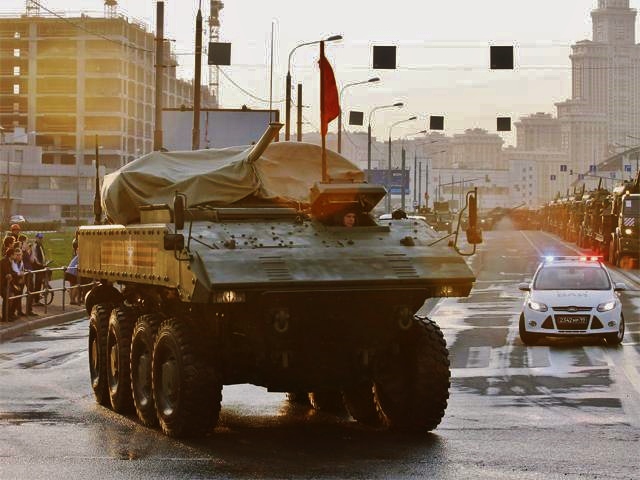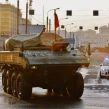
Russia’s State RIA News Agency: ‘Let the world fear us’
Publication: Eurasia Daily Monitor Volume: 12 Issue: 81
By:

The May 9 Victory Day parade in Moscow is designed to impress the world and the home public with Russia’s relentless military might. But no one seems to be counting the expenses. The last Soviet military parade in Red Square was in November 1990. Then, the Cold War ended, the Soviet Union collapsed and there were no parades until May 1995. Under President Vladimir Putin’s rule, the military displays in Moscow steadily expanded. The upcoming parade in the Russian capital is officially claimed to be the largest in post-Soviet times: Taking part will be over 16,000 men and 194 pieces of heavy military equipment, including 7 World War II–vintage T-34 tanks and a flyover by 143 aircraft (see EDM, April 28). In addition to the Moscow spectacle, some 85,000 troops, armor, warships and aircraft will be parading on May 9 in smaller military displays in many Russian cities and garrisons (Rbc.ru, April 29).
The troops, armor and aircrews have already been training for months outside of Moscow. This week, on April 29, Moscow had its first real-time rehearsal: Troops, tanks and other hardware rolled into downtown streets and Red Square, jamming evening rush-hour traffic. This dry-run parade was the first of several rehearsals to accustom the men and the hardware crews with the city street layout to guarantee all is smooth on May 9, under Putin’s watchful eye, in the presence of foreign dignitaries. No air force overflight occurred at dusk on April 29, but thousands of Muscovites lined the streets to glimpse the military hardware being driven by them. Several new prototype T-14 Armata tanks and some other newly-minted armor—T-15 infantry combat vehicles, Kurganets-25 light tracked armored vehicles, Bumerang armored personnel carriers (APC) and Koalitsiya self-propelled howitzers—were on display. The newest armor was partially covered with canvas to maintain secrecy or to keep suspense high until May 9, when that canvas will be removed. Online video stream reports of the rehearsal were available to the public (RIA Novosti, April 29).
Russian authorities and state propaganda have been using the Victory Day anniversary to promote anti-Western paranoia. Deputy Defense Minister Anatoly Antonov (a career diplomat in charge of the foreign policy activities of the Russian military) accused the West of “considering us an empire of evil.” According to Antonov, Russia is preparing to defend its borders, its interests and natural resources in the West, in the South, in the East, and in the Arctic; and it is running military exercises in all strategic directions in response to the North Atlantic Treaty Organization (NATO) concentrating its military activities against Russia. Western forces are being moved into the Baltic region, while “events in Ukraine are being used to whip up anti-Russian hysteria.” NATO’s rapid reaction forces are being expanded, military infrastructure is being developed, and the United States’ military presence in countries bordering Russia is becoming enhanced. Whenever “Americans deploy, even supposedly on a temporary basis,” insisted Antonov, “their bases appear to stay—there are over 400 such bases or military outposts surrounding Russia” (Komsomolskaya Pravda, April 30).
The Russian defense ministry spokesman, General Igor Konanashenkov, has accused the US military of sending military personnel into the battle zone in the Donbas region of eastern Ukraine (Donetsk and Luhansk provinces) to train Ukrainian soldiers to fight pro-Russia “rebels.” The Pentagon rejected the charge (Interfax, April 23). The commander of the Western Military District, Colonel-General Anatoly Sidorov, speaking at a World War II military-historical conference in Moscow, accused the US and its Western allies of entering “the first stage of a hybrid war” against Russia. “Using as a pretext the enhanced battle-readiness preparations of Russian forces on the Western strategic theater and the reunification of Crimea [with Russia], the US is painting Russia as an aggressor threatening Europe,” announced Sidorov. “The anti-Russian leaders of the Baltic states allowed the deployment on their territory of an advanced force of up to 1,000 soldiers of the US 3rd mechanized [infantry] division,” continued Sidorov. “In addition, an anti-Russian information campaign has been launched in the region” (Interfax, April 24).
While portraying the US as the main enemy, many in Moscow’s ruling elite continue to hope that Western European leaders will see reason in mending fences with Moscow on Russian terms. The Russian minister of culture, Vladimir Medinsky, expressed dismay that the leaders of France and Germany refused (together with other Western heads of state) to visit Moscow on May 9. “It is a strange decision that is contrary to French and German national interests. We want an alliance, an agreement, a compromise—but what do they [French and German leaders] want?” puzzled Medinsky, “They are too much listening to Washington.” According to Medinsky, peace in Europe has been based, for 70 years, on the 1945 agreements between Joseph Stalin and Western leaders: “If we begin to change those agreements, a new war may ensue” (RIA Novosti, April 30). RIA Novosti quotes Vasiliy Koltashov, a deputy director of the Institute for Global Research and Social Movements, a think tank in Moscow: “Westerners want to exclude Russia from European politics. A new detente in Europe could be possible, if the West suffers a major defeat, like the US in Vietnam in the 1970s. Only a humiliating rout, a bankruptcy of anti-Russian forces, could bring Europeans to their senses and give us long-lasting peace” (RIA Novosti, April 28).
The T-14 tank will be the foremost new showpiece of the Moscow parade—the first major new main battle tank produced in several decades after the T-72 and T-80 were introduced in 1970s. The T-90 battle tank, produced in recent years, was in effect a modernization of the T-72. Today, the T-14 is still a prototype, with mass production planned for the second half of 2016 or later, after a period of extensive testing. Present Russian main battle tanks, including the T-90, are considered inferior to US, German and French counterparts, while the T-14 is proclaimed to be “the best in the world.” A massive tank rearmament program is planned to produce some 2,300 T-14s before 2020. During the Cold War standoff in Central Europe, the Russian tank menace was seen in the West as the symbol of a threat from the East. Today, it may be back, at least symbolically. Russia’s State RIA news agency, in a report about the rehearsal parade on April 29, decided to quote a comment by an unnamed Internet user: “In 1943, tanks went into battle. Let the world fear us” (RIA Novosti, April 30).




